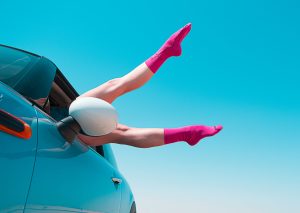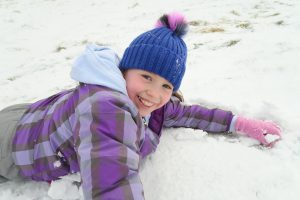There are so many changes to your body when you’re going through the menopause transition. One which is not commonly talked about is noticing a difference in your skin. Anecdotally, many women tell me that alongside noticing some skin sagging and wrinkles, their skin seems to become more delicate and sensitive. This can be a real problem for runners whose skin is regularly exposed to the elements, to friction, to sweat and to frequent washing.
I’ve decided to do a little mini-series looking at the skin changes in perimenopause that can affect us as runners. Let’s start with skin chafing.
The horrors of chafed skin.
If you’ve ever had chafed skin you’ll know how intensely painful it can be, especially when you hop into your post-run shower. Ouch! I was so badly chafed on my inner thighs after my first half marathon (admittedly in the wrong shorts and the pouring rain), that I had to use surgical dressings to be able to walk and go to work the next day. I also have some scars on my upper arm from chafing of my sleeves during a marathon. I was wearing exactly what I had worn on my long practice runs but I think the extra exertion on race day made me sweat more heavily than usual. So, although a bit of chafing might not sound like much, it can be nasty and is definitely worth avoiding if you can.
What happens when skin gets chafed?
Chafing can either be caused by skin rubbing against skin or fabric rubbing against skin. The friction wears away the top layer of skin exposing the more delicate skin cells underneath. These skin cells aren’t yet mature enough to be on the outside and they’re more fragile. They’re surrounded by small nerve endings and blood vessels which become exposed too. That’s why chafed skin can bleed and be intensely painful.
Why can chafing increase in perimenopause?
Women tell me that even though they’ve been running for years and mastered the art of caring for their skin and avoiding chafing, when they hit perimenopause it seems to become a problem. There are a few reasons why that might be:
- Increased sweating during running
- Breast and body shape changes so clothes fit differently
- Reduced resiliency and plumpness of the skin due to changing hormone levels
How to prevent skin chafing when running
Prevention is always better than cure so here are a few tips to keep your run comfortable and your skin intact:
- Wear correctly fitting clothes. Baggier clothes will move around more. Look for a good fit in your problem area so, for example, slightly longer Lycra shorts will stop your thighs rubbing together.
- Get re-fitted for your sports bra. 70 per cent of women wear a bra that’s the wrong size. The main error is a chest band that’s too big and a cup that’s too small. Getting a perfect fit reduces breast movement and therefore reduces risk of rubbing from a moving chest band. Breast size changes during perimenopause and post menopause so these are good times to get a fitting.
- Choose technical fabrics. Soft, seam free fabrics are best. Wet clothes will chafe much more quickly and technical fabrics wick sweat away from the skin and dry quickly. This is especially important if you’re finding you’re sweating more heavily than you used to. The areas that you sweat from may change too. My upper chest for example never used to be an area that I sweated much from but on a recent run I looked as if someone had thrown a bottle of water at my front, there was very little sweat on my back – weird!
- Use a barrier cream. You can use a lubricant such as Vaseline, or Body Glide and apply it before you run. Alternatively, particularly if you’re going to get wet, use Sudocrem or Bepanthen (a nappy cream for babies) to protect the skin.
- Moisturise regularly. Menopausal skin tends to be on the dry side so getting into the habit of moisturising regularly, especially after washing is a good idea. No need for expensive products, Nivea Soft is my top recommendation.
- Keep cool. Do what you can to reduce sweating by keeping as cool as possible. Don’t over dress, your thermostat may have changed and your body often needs to work harder to keep you cool. Choose shady routes on sunny days. Pre-cool with an icy drink before you run and keep well hydrated.
- Use your antiperspirant. These won’t directly protect the skin but they can reduce sweating by blocking pores. Being a bit more liberal with your antiperspirant can help but don’t use them near your vulva.
How to treat chafed skin
Skin chafing happens to all of us from time to time despite our best intentions. Here are some tips for treating it:
- Clean the skin as soon as possible. Use warm water and a mild soap. Avoid strongly perfumed body washes. It will sting a bit at first but keep going.
- Dry the skin thoroughly with a soft, clean towel.
- Apply Sudocrem (this isn’t a sponsored post – I just love the stuff!), it contains zinc oxide which is a mild antiseptic and it creates a barrier to prevent further damage. Another good choice of antiseptic is Savlon.
- Leave the skin exposed to the air if you can.
- Cover with a sterile dressing if you need to, to protect the skin from further rubbing.
Skin usually heals in a few days. It might feel a bit itchy and be slightly red but it shouldn’t get sticky or smelly and the redness should gradually reduce rather than get bigger and spread. If any of these things happen, it indicates possible infection. Speak to your pharmacist about what you can buy over the counter and whether you need to see your doctor.
If you’ve enjoyed this post, you’ll love my weekly tips and motivation for menopausal runners. Join hundreds of other women by signing up to get my newsletter below..








3 Comments